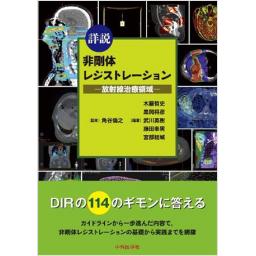1) 放射線治療における非剛体画像レジストレーション利用のためのガイドライン 2018年版 [Internet]. 2018. Available from : https://www.jastro.or.jp/medicalpersonnel/guideline/dir_guideline2018.pdf
2) Brock KK, Mutic S, McNutt TR, et al. Use of image registration and fusion algorithms and techniques in radiotherapy : Report of the AAPM Radiation Therapy Committee Task Group No. 132. Med Phys. 2017 ; 44 : e43-76.
3) Fontanilla HP, Klopp AH, Lindberg ME, et al. Anatomic distribution of [(18) F] fluorodeoxyglucose-avid lymph nodes in patients with cervical cancer. Pract Radiat Oncol. 2013 ; 3 : 45-53.
4) Yang J, Amini A, Williamson R, et al. Automatic contouring of brachial plexus using a multi-atlas approach for lung cancer radiation therapy. Pract Radiat Oncol. 2013 ; 3 : e139-47.
5) Hoang Duc AK, Eminowicz G, Mendes R, et al. Validation of clinical acceptability of an atlas-based segmentation algorithm for the delineation of organs at risk in head and neck cancer. Med Phys. 2015 ; 42 : 5027-34.
6) Chao KS, Bhide S, Chen H, et al. Reduce in variation and improve efficiency of target volume delineation by a computer-assisted system using a deformable image registration approach. Int J Radiat Oncol Biol Phys. 2007 ; 68 : 1512-21.
7) Lee DS, Woo JY, Kim JW, et al. Re-irradiation of hepatocellular carcinoma : clinical applicability of deformable image registration. Yonsei Med J. 2016 ; 57 : 41-9.
8) Senthi S, Griffioen GH, van Sornsen de Koste JR, et al. Comparing rigid and deformable dose registration for high dose thoracic re-irradiation. Radiother Oncol. 2013 ; 106 : 323-6.
9) Hardcastle N, van Elmpt W, De Ruysscher D, et al. Accuracy of deformable image registration for contour propagation in adaptive lung radiotherapy. Radiat Oncol. 2013 ; 8 : 243.
10) Jung SH, Yoon SM, Park SH, et al. Four-dimensional dose evaluation using deformable image registration in radiotherapy for liver cancer. Med Phys. 2013 ; 40 : 011706.
11) Yang C, Liu F, Ahunbay E, et al. Combined online and offline adaptive radiation therapy : a dosimetric feasibility study. Pract Radiat Oncol. 2014 ; 4 : e75-83.
12) Song WY, Wong E, Bauman GS, et al. Dosimetric evaluation of daily rigid and nonrigid geometric correction strategies during on-line image-guided radiation therapy (IGRT) of prostate cancer. Med Phys. 2007 ; 34 : 352-65.
13) Qin A, Sun Y, Liang J, et al. Evaluation of online/offline image guidance/adaptation approaches for prostate cancer radiation therapy. Int J Radiat Oncol Biol Phys. 2015 ; 91 : 1026-33.
14) Tait LM, Hoffman D, Benedict S, et al. The use of MRI deformable image registration for CT-based brachytherapy in locally advanced cervical cancer. Brachytherapy. 2016 ; 15 : 333-40.
15) Teo BK, Bonner Millar LP, Ding X, et al. Assessment of cumulative external beam and intracavitary brachytherapy organ doses in gynecologic cancers using deformable dose summation. Radiother Oncol. 2015 ; 115 : 195-202.
16) Sabater S, Andres I, Sevillano M, et al. Dose accumulation during vaginal cuff brachytherapy based on rigid/deformable registration vs. single plan addition. Brachytherapy. 2014 ; 13 : 343-51.
17) Kato S, Tran DNL, Ohno T, et al. CT-based 3D Dose-Volume Parameter of the Rectum and Late Rectal Complication in Patients with Cervical Cancer Treated with High-Dose-Rate Intracavitary Brachytherapy. J Radiat Res. 2010 ; 51 : 215-21.
18) Georg P, Potter R, Georg D, et al. Dose effect relationship for late side effects of the rectum and urinary bladder in magnetic resonance image-guided adaptive cervix cancer brachytherapy. Int J Radiat Oncol Biol Phys. 2012 ; 82 : 653-7.
19) Vinogradskiy Y, Schubert L, Diot Q, et al. Regional lung function profiles of stage I and III lung cancer patients : an evaluation for functional avoidance radiation therapy. Int J Radiat Oncol Biol Phys. 2016 ; 95 : 1273-80.
20) Kadoya N, Cho SY, Kanai T, et al. Dosimetric impact of 4-dimensional computed tomography ventilation imaging-based functional treatment planning for stereotactic body radiation therapy with 3-dimensional conformal radiation therapy. Pract Radiat Oncol. 2015 ; 5 : e505-12.
21) Kida S, Bal M, Kabus S, et al. CT ventilation functional image-based IMRT treatment plans are comparable to SPECT ventilation functional image-based plans. Radiother Oncol. 2016 ; 118 : 521-7.
22) Yamamoto T, Kabus S, Bal M, et al. The first patient treatment of computed tomography ventilation functional image-guided radiotherapy for lung cancer. Radiother Oncol. 2016 ; 118 : 227-31.
23) Yang J, Garden AS, Zhang Y, et al. Variable planning margin approach to account for locoregional variations in setup uncertainties. Med Phys. 2012 ; 39 : 5136-44.
24) Schreibmann E, Waller AF, Crocker I, et al. Voxel clustering for quantifying PET-based treatment response assessment. Med Phys. 2013 ; 40 : 012401.
25) Badawi AM, Weiss E, Sleeman WC, et al. Classifying geometric variability by dominant eigenmodes of deformation in regressing tumours during active breath-hold lung cancer radiotherapy. Phys Med Biol. 2012 ; 57 : 395-413.
26) Hardcastle N, Hofman MS, Hicks RJ, et al. Accuracy and utility of deformable image registration in (68) Ga 4D PET/CT assessment of pulmonary perfusion changes during and after lung radiation therapy. Int J Radiat Oncol Biol Phys. 2015 ; 93 : 196-204.
27) Palma DA, van Sornsen de Koste J, Verbakel WF, et al. Lung density changes after stereotactic radiotherapy : a quantitative analysis in 50 patients. Int J Radiat Oncol Biol Phys. 2011 ; 81 : 974-8.
28) Chetty IJ, Rosu-Bubulac M. Deformable registration for dose accumulation. Semin Radiat Oncol. 2019 ; 29 : 198-208.
29) Heukelom J, Fuller CD. Head and neck cancer adaptive radiation therapy (ART) : conceptual considerations for the informed clinician. Semin Radiat Oncol. 2019 ; 29 : 258-73.
